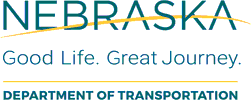Nebraska LTAP
Date of this Version
3-2007
Document Type
Article
Citation
NDOR Research Project Number SPR-1(05) P575
Abstract
The objectives of this research were to study unsafe actions of motor vehicle drivers at railroadhighway grade crossings, to evaluate centerline barriers in reducing those unsafe driver actions, and to note any maintenance or other issues with the barriers. Driver actions were observed at two railroad crossings before and after installation of centerline barriers. A comparison of observed driver actions in the pre- and post-barrier periods provided information on the effectiveness of the barriers in reducing unsafe driver actions while periodic inspection of the centerline barriers provided information on maintenance needs. A major concern of the Nebraska Department of Roads is the potential for crashes at railroad-highway grade crossings resulting from unsafe actions of motorists such as, rushing the gates to beat an oncoming train or playing “chicken” with an approaching train, among others. Playing “chicken” refers to intentional standing of a motor vehicle on railroad tracks and only moving when the train hits the brakes. Crashes at railroad-highway crossings may not necessarily involve trains as some driver actions (e.g., backing up, and U-turns) may result in crashes involving motor vehicles only. In this research the crossing at North 141st Street in the City of Waverly, NE and the crossing at “M” Street in the City of Fremont, NE were monitored with the help of day and night vision cameras and digital video recorders. Motor vehicle driver actions were observed whenever the gates were down and instances of unsafe actions noted. In an effort to reduce gate rushing and other unsafe motorist actions, the researchers installed flexible rubber and plastic barriers on both sides of the crossings along roadway centerlines to prevent motorists from going around the gates. The actions of motor vehicle drivers were monitored in the post-barrier period and compared to the pre-install period using appropriate statistical tools. Results of the comparison show that fewer unsafe driver actions were observed after installation of the centerline barriers. In particular, installation of centerline barriers significantly reduced instances of gate rushing at the two study sites. Centerline barriers are recommended for use at railroad crossings where unsafe driver actions (e.g., gate rushes) are a concern.
Damage to the barriers as a result of abuse from roadway vehicles was noted while no snowplowing issues came to the attention of the researchers during the study period. The amount of damage was a function of traffic volume, percentage of trucks, and if sharp turns were involved. Finally, this study revealed instances of pedestrians and bicyclists engaged in unsafe actions at railroad crossings, which are recommended for investigation in a future study.

